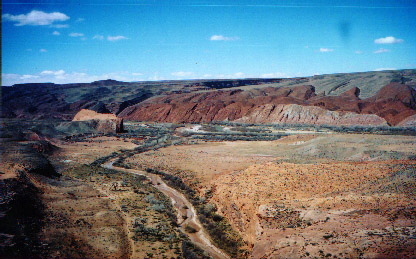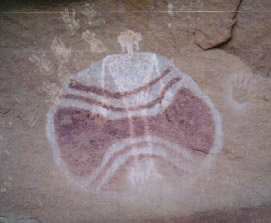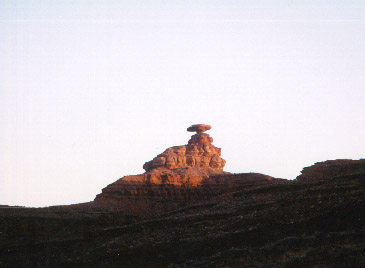After the struggle with the wind both on land and coming down the river, I seemed to achieve some kind of shift in consciousness and was able to lay aside my rational modern western world mind and tune into the non-physical entities that were "floating" around our campsite. Our campsite was an important junction when the Anasazi inhabited the region. Many lived up Chinle Wash and met and traded with various travelers who came down the San Juan River.
Chinle Wash has always had a special energy. Tony Hillerman's novel A Thief of Time was placed here; he called it the "Many Ruins Canyon." As most know that book deals with one murder in the past and a near-murder in the time of the novel. The directions we had obtained from various insiders spoke of Navajos shooting at white people who went too far up the canyon, permit or not. The number of ruins in the canyon shows how important it was to the Anasazi. So it is not surprising that the spirit of someone killed there would tend to linger.
 The entity I contacted, Bew Begay, had been killed near our campsite when he accused a wandering trader of cheating him. He viewed the killing as unjust and was so angry about it that he had spent the last 800 years stuck in what the Tibetans call a "bardo" or plane of consciousness or, in other words, a purgatory. The Tibetans think that the thought you have in your mind at the moment of death is very powerful. It controls your time in the bardo and carries forward into other lives. Bew Begay was so angry at his unjust killing and so filled with a desire for revenge that he could not move on to anything else. Fortunately his rage was directed only at his killer. I heard his words in my mind. This is how he saw us.
The entity I contacted, Bew Begay, had been killed near our campsite when he accused a wandering trader of cheating him. He viewed the killing as unjust and was so angry about it that he had spent the last 800 years stuck in what the Tibetans call a "bardo" or plane of consciousness or, in other words, a purgatory. The Tibetans think that the thought you have in your mind at the moment of death is very powerful. It controls your time in the bardo and carries forward into other lives. Bew Begay was so angry at his unjust killing and so filled with a desire for revenge that he could not move on to anything else. Fortunately his rage was directed only at his killer. I heard his words in my mind. This is how he saw us.
 Shipp and Norm emerged from their tents just after dawn. This went against Bew's sensibilities,
Shipp and Norm emerged from their tents just after dawn. This went against Bew's sensibilities,
 "The Navajo rise each day and personally greet the dawn. You white men get up and begin cooking your breakfast. You do not spend even one second acknowledging the power and light of the sun. Shipp, you claim to have meditated some; but you have barely succeeded in bringing your attention out of the dream state. When you leave your body like me, you will see that your mind was almost constantly occupied with keeping your body comfortable. As you get up you think of coffee and breakfast, and pay no attention to the beauty unfolding around you, not to speak of the impermanent of the whole world. You have seen signs of a civilization that has passed away. Do you think your great culture will endure forever? Nothing in this world lasts? You're made of dust and to dust you will return."
"The Navajo rise each day and personally greet the dawn. You white men get up and begin cooking your breakfast. You do not spend even one second acknowledging the power and light of the sun. Shipp, you claim to have meditated some; but you have barely succeeded in bringing your attention out of the dream state. When you leave your body like me, you will see that your mind was almost constantly occupied with keeping your body comfortable. As you get up you think of coffee and breakfast, and pay no attention to the beauty unfolding around you, not to speak of the impermanent of the whole world. You have seen signs of a civilization that has passed away. Do you think your great culture will endure forever? Nothing in this world lasts? You're made of dust and to dust you will return."
 In spite of these words the routine of cooking and eating breakfast and packing up took me out of this state. We rowed the raft across the river and tied up at the head of an island at the mouth of the wash. Wearing our Tingleys, we slipped through the mud and followed various cattle trails up Chinle Wash. The path curved around and followed the cliffs a set of ruins high on a ledge above us. These were the Baseball Man pictograph ruins. I was particularly intrigued by the large amount of wood remaining on the roof of one section. We continued on and climbed up one bench and found a great ruin back in an alcove. There was a ruin much higher up the cliff that we did not attempt to climb. Norm and I circled around and found a way up to the top of the cliff and walked around on a huge area of slickrock. We eventually found the ruin but it was impossible to climb down to it without ropes (which are not allowed). On the way back we passed another ruin up in an alcove with Moqui steps leading up to it. But it was too steep a climb for us and so we left it for another time.
In spite of these words the routine of cooking and eating breakfast and packing up took me out of this state. We rowed the raft across the river and tied up at the head of an island at the mouth of the wash. Wearing our Tingleys, we slipped through the mud and followed various cattle trails up Chinle Wash. The path curved around and followed the cliffs a set of ruins high on a ledge above us. These were the Baseball Man pictograph ruins. I was particularly intrigued by the large amount of wood remaining on the roof of one section. We continued on and climbed up one bench and found a great ruin back in an alcove. There was a ruin much higher up the cliff that we did not attempt to climb. Norm and I circled around and found a way up to the top of the cliff and walked around on a huge area of slickrock. We eventually found the ruin but it was impossible to climb down to it without ropes (which are not allowed). On the way back we passed another ruin up in an alcove with Moqui steps leading up to it. But it was too steep a climb for us and so we left it for another time.
 We got back to the raft and pushed off at 1:00 p.m. We were now in the canyon which grew higher above us as we followed the river which had cut deeper with each mile. There were no more ruins and we tried to learn something about the different layers from our guidebook. But our attention kept wandering back to food. Norm and Colin had gotten some wonderful Navajo tacos at Valle's restaurant at the take-out site. We decided to go all the way and not spend another night on the river. It gradually grew darker and colder. The river slowed as it flattened out. With about a mile and a half to go it was completely dark. We hung up on invisible rocks a few times and spent many minutes shifting our weight and pushing with the oars to get off.
We got back to the raft and pushed off at 1:00 p.m. We were now in the canyon which grew higher above us as we followed the river which had cut deeper with each mile. There were no more ruins and we tried to learn something about the different layers from our guidebook. But our attention kept wandering back to food. Norm and Colin had gotten some wonderful Navajo tacos at Valle's restaurant at the take-out site. We decided to go all the way and not spend another night on the river. It gradually grew darker and colder. The river slowed as it flattened out. With about a mile and a half to go it was completely dark. We hung up on invisible rocks a few times and spent many minutes shifting our weight and pushing with the oars to get off.
 We grew worried about missing the take-out. Only Norm had seen it. If we missed it, the next place to take out was 26 miles away and our car was not there. Our flashlights grew dim and we could barely make out the shoreline let alone see any landmarks. But suddenly a small campfire appeared. Luckily, some people had camped at the take-out. As we packed the minivan in the dark, two more rafts emerged from the dark. They were paddling smaller rafts and tried to go from Sand Island to here in one day but had gotten a late start.
We grew worried about missing the take-out. Only Norm had seen it. If we missed it, the next place to take out was 26 miles away and our car was not there. Our flashlights grew dim and we could barely make out the shoreline let alone see any landmarks. But suddenly a small campfire appeared. Luckily, some people had camped at the take-out. As we packed the minivan in the dark, two more rafts emerged from the dark. They were paddling smaller rafts and tried to go from Sand Island to here in one day but had gotten a late start.
 By the time all was packed (deflating the raft proved to be very difficult), Valle's and the rest of Mexican Hat was closed. We didn't get the Navajo tacos. Norm and Colin settled for McDonald's in Kayenta, sixty miles away. I was lucky to find some vegetarian soup at a convenience store there.
By the time all was packed (deflating the raft proved to be very difficult), Valle's and the rest of Mexican Hat was closed. We didn't get the Navajo tacos. Norm and Colin settled for McDonald's in Kayenta, sixty miles away. I was lucky to find some vegetarian soup at a convenience store there.
 During the sixty-mile drive to Kayenta, Bew Begay's presence came into my mind again. I mentally asked him, "What lesson should I take away from this place?"
During the sixty-mile drive to Kayenta, Bew Begay's presence came into my mind again. I mentally asked him, "What lesson should I take away from this place?"
 "You have seen the remains of a vanished civilization. These people lived very happily until the climate changed and they realized that they would barely have enough food to eat. You have also seen mountains of sandstone that were once the bottom of an ocean. You have seen how wind and water are wearing them away. You have seen signs of your own civilization dumping trash into water that sustains life in the area. All of these are obvious signs that nothing in the physical world lasts. As you leave this area, reflect upon what does last and focus on that. You have made a start in this direction but you have to develop a heart of iron to find the hidden jewel within you. Do not stop until you have found it."
"You have seen the remains of a vanished civilization. These people lived very happily until the climate changed and they realized that they would barely have enough food to eat. You have also seen mountains of sandstone that were once the bottom of an ocean. You have seen how wind and water are wearing them away. You have seen signs of your own civilization dumping trash into water that sustains life in the area. All of these are obvious signs that nothing in the physical world lasts. As you leave this area, reflect upon what does last and focus on that. You have made a start in this direction but you have to develop a heart of iron to find the hidden jewel within you. Do not stop until you have found it."
 We spent the night in a Holiday Inn in Kayenta and drove on to Flagstaff to drop off the raft the next day. We spent the night in Phoenix and I flew back later that day.
We spent the night in a Holiday Inn in Kayenta and drove on to Flagstaff to drop off the raft the next day. We spent the night in Phoenix and I flew back later that day.


